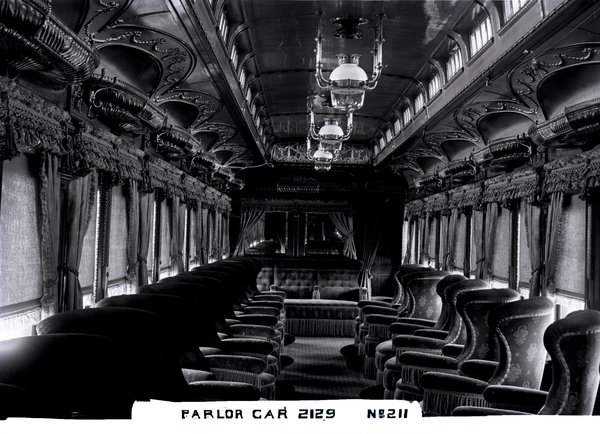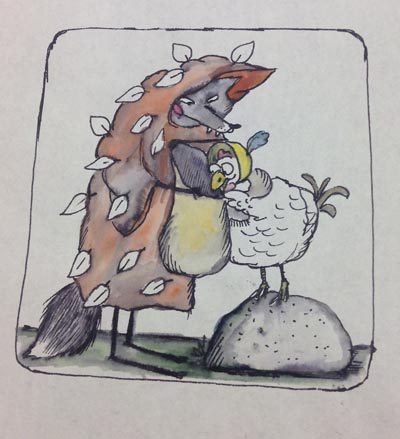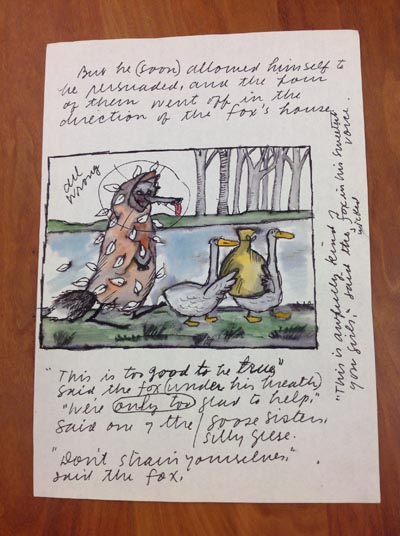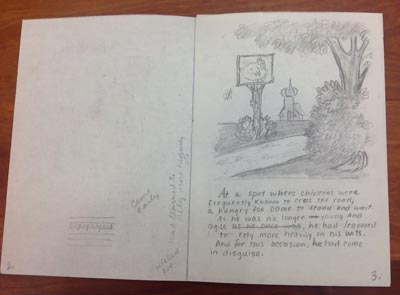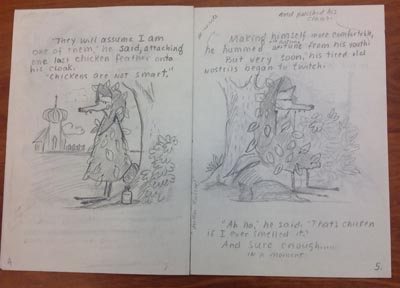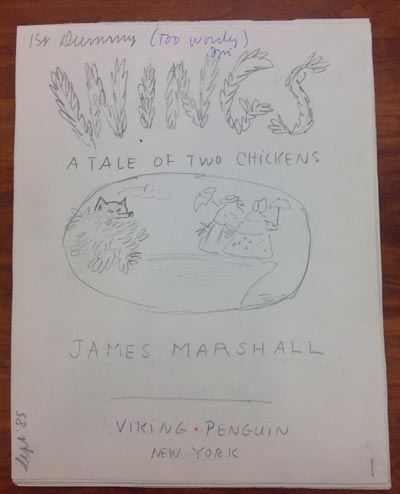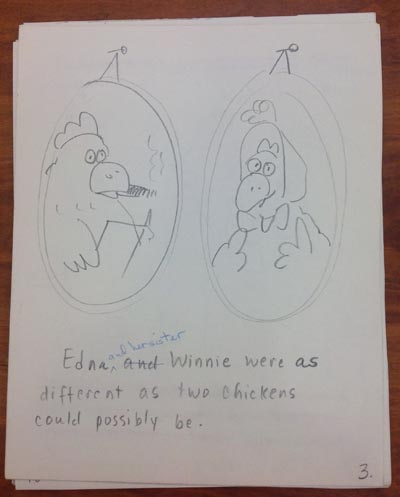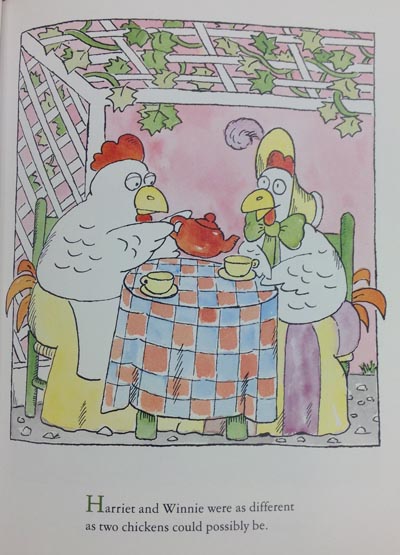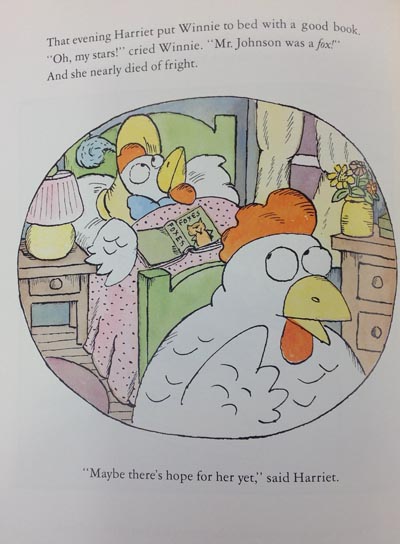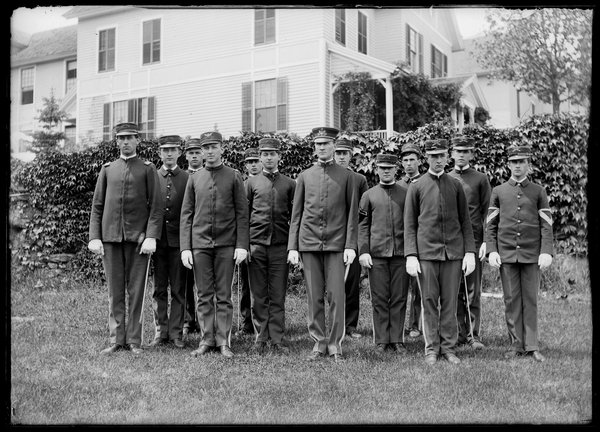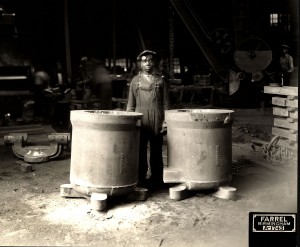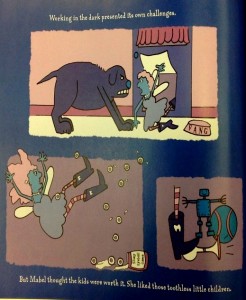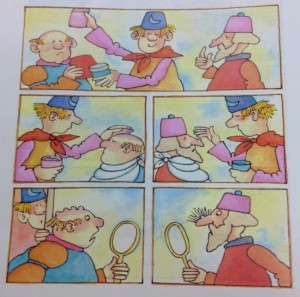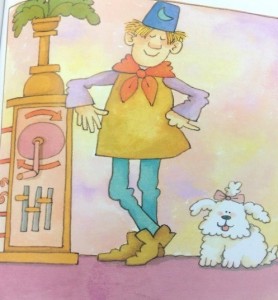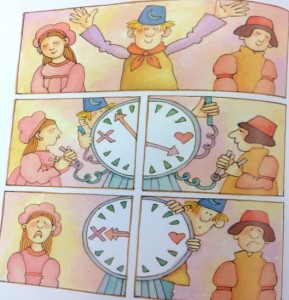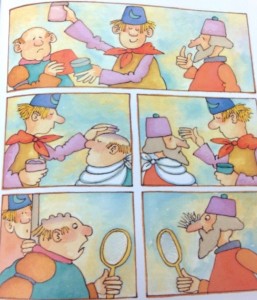 Charles Boer was a respected and wildly popular professor at UConn arriving in 1966 and retiring in 1992 as a full professor from the English Department, where he specialized in teaching mythology, poetry, and individual 20th-century writers from Charles Olson to Frank O’Hara, Gertrude Stein to Ernest Hemingway. He also helped establish the Charles Olson Archives, now the Charles Olson Research Collection, along with George Butterick, which are part of the University’s Archives and Special Collections at the Thomas J. Dodd Research Center. Boer was also a gifted translator of ancient Greek and Latin. He was nominated for the National Book Award for his translation from ancient Greek of The Homeric Hymns in 1971, and is known for his translation from Latin of Ovid’s Metamorphoses (1989) and Marsilio Ficino’s Book of Life (1980). His personal papers and manuscripts will be preserved in Archives and Special Collections… Read More >
Charles Boer was a respected and wildly popular professor at UConn arriving in 1966 and retiring in 1992 as a full professor from the English Department, where he specialized in teaching mythology, poetry, and individual 20th-century writers from Charles Olson to Frank O’Hara, Gertrude Stein to Ernest Hemingway. He also helped establish the Charles Olson Archives, now the Charles Olson Research Collection, along with George Butterick, which are part of the University’s Archives and Special Collections at the Thomas J. Dodd Research Center. Boer was also a gifted translator of ancient Greek and Latin. He was nominated for the National Book Award for his translation from ancient Greek of The Homeric Hymns in 1971, and is known for his translation from Latin of Ovid’s Metamorphoses (1989) and Marsilio Ficino’s Book of Life (1980). His personal papers and manuscripts will be preserved in Archives and Special Collections… Read More >
In Celebration of Chanukah
Riding in style
Are you traveling during the holidays? Wouldn’t it be great to take a cross-country train trip riding in this fancy parlor car?
This parlor car, owned by the New York, New Haven & Hartford Railroad, would be so luxurious you would never want to get to your destination.
You’ll find this image and more in the digital repository, in the New Haven Railroad Glass Negatives Collection.
Encountering the Hand, the Ephemeral, the Unexpected in the Archive
Louis Goddard is a PhD candidate in English at University of Sussex and describes his research experience during a visit in September as recipient of a 2014 Strochlitz Travel Grant. Travel grants are awarded bi-annually to scholars to support their travel to and research in Archives and Special Collections at the University of Connecticut.
My PhD project focuses on the prose writings of the contemporary British poet J.H. Prynne. As well as at least thirty volumes of poetry, Prynne has, over the half-century course of his career, produced a wide range of prose work, including reviews, essays, lectures and commentaries. Perhaps his most favored outlet, however, has been in correspondence. The Thomas J. Dodd Research Center holds hundreds of letters written by Prynne, the vast majority to the American poets Charles Olson and Ed Dorn, making a two-week trip to the University of Connecticut a vital part of my research as I head into the second year of the PhD.
Having read quotations from the letters in a number of existing scholarly works – notably those by my supervisor at the University of Sussex, Keston Sutherland – I thought I had a fairly good idea of what to expect from the archives: letters full of clear opinions about art and poetry, both Prynne’s and other people’s – almost crib sheets for the poems themselves, though this is an attitude that Prynne himself would certainly not endorse. Many of the letters did indeed conform to my expectations; Prynne writes to Olson, in particular, in an at times shockingly direct style, revealing his profound hopes for what, in the early- to mid-1960s, he conceived as their shared poetic project, and his equally profound disappointment when Olson began to withdraw from the correspondence as the decade progressed. 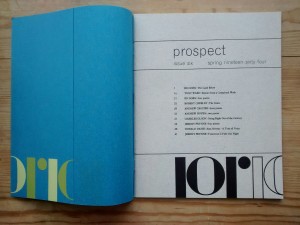
Even more interesting, however, were the aspects of the letters that I hadn’t anticipated. As part of my research, I recently completed a paper on a number of ‘little magazines’ of the 1960s, looking particularly at the legacy of Gael Turnbull’s seminal Migrant (1959–60). One of the beneficiaries of this legacy was the Cambridge-based Prospect (1959–64) – no relation of the current political magazine of the same name – which Prynne edited for its much-delayed final issue in 1964. Prynne’s opening letters to Olson and Dorn are both typed on Prospect-stamped stationery, with the younger poet tentatively soliciting work to be published in the forthcoming issue. As the correspondence progresses, the reader gets a sense of the practical and financial obstacles confronting any would-be little magazine publisher in the early ’60s, and is given insight into to the decisions which led Prynne to change the format for Prospect‘s final issue, making the magazine physically larger, removing all advertisements, and ultimately giving it away for free to interested parties.
Another aspect of the letters which struck me was the frequency of comparisons between the British and North American poetry scenes at the time, and Prynne’s efforts, both poetic and practical, to bridge the Atlantic gap. Though I had visited California and Florida as a child, arriving at Storrs involved a certain amount of ‘culture-shock’ – situated near the seaside town of Brighton, Sussex barely has an on-campus supermarket, let alone a hotel, a high school and a dairy farm (though, being British, it does have the advantage of its own dedicated railway station). I can only imagine this as the reverse of what Ed Dorn must have felt when, partly as a result of Prynne’s ministrations, he was offered a teaching post at the new University of Essex in 1965, an institution whose campus was at that point only half-built.
As well as scheming to secure fellowships and teaching positions for his American correspondents, and even offering to put up visiting poets in his rooms at Gonville and Caius College in Cambridge, the young Prynne was active in promoting new American work to mainstream British publishers. Writing to Dorn in October 1963, having received an encouraging letter from Calder Publishing about Dorn’s novel The Rites of Passage, Prynne jokes about ‘the lit. agency which I seem (& am more than pleased, as you know) to be running.’ Dorn, for his part, was skeptical – as he more or less correctly predicted in a note to Olson the previous month, ‘Prynne writes from england that he sent the novel to John Calder and go [sic] back a very favorable letter. But I’m not that dumb that I don’t dig that in 3 months I’ll get a letter from him saying they almost took it.’ When further efforts were made to place the novel with André Deutsch, not only was it again rejected, but the typescript was lost in the post, setting off a chain of increasingly irate letters from Prynne to Diana Athill.
The l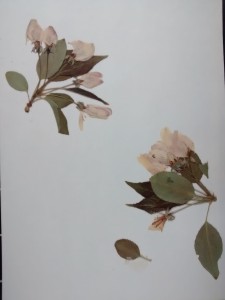 etter from Dorn to Olson quoted above is part of a collection that I hadn’t originally planned to consult when applying to visit the Dodd Center, but which turned out to be one of the most fruitful aspects of the trip. Having spent some time mastering the two poets’ near-impenetrable handwriting, it was fascinating to switch from letters by Prynne to letters about him, revealing a certain ambivalence in both Olson’s and Dorn’s attitudes to the reception of their work in Britain. Similarly instructive were references to Donald Davie, the British poet formerly associated with ‘the Movement’ who played a crucial role in supporting Prynne’s early academic career and served as head of the Literature Department at Essex when Dorn first came to England. In one particularly opaque letter to Olson, Dorn shifts from an assessment of Davie – often referred to, tellingly, by his initials, ‘D.A.D.’ – to the following ambiguous statement: ‘I can’t but think of the English interest in our things other than interesting, and for myself unseful [sic], because I need to think there with them.’ Whether he meant to type ‘useful’ or ‘unuseful’ is difficult to determine, even in context.
etter from Dorn to Olson quoted above is part of a collection that I hadn’t originally planned to consult when applying to visit the Dodd Center, but which turned out to be one of the most fruitful aspects of the trip. Having spent some time mastering the two poets’ near-impenetrable handwriting, it was fascinating to switch from letters by Prynne to letters about him, revealing a certain ambivalence in both Olson’s and Dorn’s attitudes to the reception of their work in Britain. Similarly instructive were references to Donald Davie, the British poet formerly associated with ‘the Movement’ who played a crucial role in supporting Prynne’s early academic career and served as head of the Literature Department at Essex when Dorn first came to England. In one particularly opaque letter to Olson, Dorn shifts from an assessment of Davie – often referred to, tellingly, by his initials, ‘D.A.D.’ – to the following ambiguous statement: ‘I can’t but think of the English interest in our things other than interesting, and for myself unseful [sic], because I need to think there with them.’ Whether he meant to type ‘useful’ or ‘unuseful’ is difficult to determine, even in context.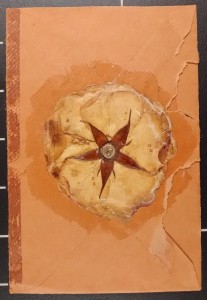
When reading correspondence fifty or more years down the line, short notes and other apparent ephemera often turn out to be more interesting than long, deliberate letters. This was certainly the case with the letters from Helene Dorn (née Buck), Ed Dorn’s first wife. In her letters to Olson, I came across a pressed rose picked not far from where I grew up in East Anglia, carried across the Atlantic, then posted to Olson’s house at 28 Fort Square, Gloucester, MA. Dorn’s two-way correspondence with Valarie Raworth, meanwhile, could have served as the basis for an entire PhD thesis on the unenviable position of ‘poet’s wife’ in a ’60s artistic scene no less patriarchal for its avant-garde credentials. Dorn often writes to Raworth with a real weariness about her day-to-day tasks, typing up her husband’s work from near-illegible manuscripts while simultaneously looking after the children and keeping their house in Pocatello, Idaho.
During my time in Storrs, I was lucky enough to stay at the Altnaveigh Inn, where there were few such household obligations to distract me – dating from 1734, the inn is known locally for hosting Olson while he taught a course at the university in the autumn of 1969. Writing this account back in London, I could wish for at least another two weeks at UConn, exploring letters from the less famous members of the Dorn-Olson correspondence nexus. But as Lytle Shaw of New York University pointed out when I met him briefly at the Dodd Center, working in archives is a bit like shopping – even if you arrive with a fixed plan, you’re as likely as not to leave with something completely unexpected.
– Louis Goddard
Janet Lawler’s final post: It’s all about story.
IT’S ALL ABOUT STORY
When I began my research on the relationship between text and art in picture books, I was hoping to uncover the “secrets” of some of the author/illustrators whose work is housed in the Northeast Children’s Literature Collection archives. I studied a number of different collections, and I am leaving with many ideas of how to improve my craft. My writing process will now include consistent creation of picture book mock-ups (dummies), and I have a greater understanding of specific approaches to writing text that “leaves room” for an illustrator.
Interestingly, though, I conclude my research with one overriding thought. The very best picture books—whether written by an author and illustrated by someone else, or created by an author/illustrator—have at their heart a good story. So authors and author/illustrators have equal opportunity to begin their creative picture book journeys in the same place – at the deep well of great stories we each have within us, stories about memorable characters who change as they solve problems or encounter conflict.
Revising text plays an important role in refining such stories (although the author/illustrator also revises art to strengthen his or her work). But always, it is the story that is the starting point. I will share a fine example:
WINGS: A TALE OF TWO CHICKENSby James Marshall
The kernel of this story appears to have been James Marshall’s vision of an old, hungry fox trying to outwit foolish fowl to find a meal. A preliminary sketch shows the disguised fox tricking a chicken into a bag.
Marshall, James. WINGS: A Tale of Two Chickens. Sketch of fox bagging chicken. Series I, Box 12: Folder 217 of James Marshall Papers. All rights reserved. No reproduction of any kind allowed.
When two silly geese sisters offer to help transport the heavy bag, the fox says, “This is too good to be true.”
Marshall, James. WINGS: A Tale of Two Chickens. Sketch of fox and geese, in Series I, Box 12: Folder 217 of James Marshall Papers. All rights reserved. No reproduction of any kind allowed.
An incomplete, early dummy of this story line shows a “chicken crossing” sign and a fox hiding behind a tree:
Marshall, James. WINGS: A Tale of Two Chickens. Untitled, incomplete dummy, p.3. Series I, Box 12: Folder 216 of James Marshall Papers. All rights reserved. No reproduction of any kind allowed.
The text on this opening page reads:
At a spot where chickens were
frequently known to cross the road,
a hungry fox came to stand and wait.
As he was no longer young
and agile, he had learned
to rely more heavily on his wits.
And for this occasion, he had come
in disguise.
The focus on the fox as protagonist continues in this version of the story, where we see the fox waiting in his chicken disguise:
Marshall, James. WINGS: A Tale of Two Chickens. Untitled, incomplete dummy, pp. 4–5. Series I, Box 12: Folder 216 of James Marshall Papers. All rights reserved. No reproduction of any kind allowed.
However, it appears that James Marshall soon decided he could tell a better story from another angle (the incomplete dummy ends on page 6).
The first complete dummy reveals that the plot has taken a very different turn. Marshall completely switches the beginning to focus on two chickens who are close friends (maybe the two silly goose sisters in his preliminary sketches inspired this turn); the fox still plays a key role, but he is no longer a protagonist.
The title of the book, shown on this hand-drawn dummy cover, is:
WINGS
A TALE OF TWO CHICKENS
Marshall, James. WINGS: A Tale of Two Chickens. Sept. ’85 dummy, cover. Series I, Box 12: Folder 215 of James Marshall Papers. All rights reserved. No reproduction of any kind allowed.
Two chickens, with parasols, stand side by side at the edge of a precipice, and a fox hides in bushes in the background. The reader immediately knows this is a story of friendship and danger, and the first line of the dummy introduces Edna and Winnie (Harriet and Winnie in the published version) who are “as different as two chickens could possibly be.”
Marshall, James. WINGS: A Tale of Two Chickens. Sept. ’85 dummy, p.3. Series I, Box 12: Folder 215 of James Marshall Papers. All rights reserved. No reproduction of any kind allowed.
The first page in the published book shows the two good friends sharing tea:
Marshall, James. WINGS: A Tale of Two Chickens (New York: Viking Kestrel, 3. Photo taken from CLC C38, Archives and Special Collections at the Thomas J. Dodd Research Center, University of Connecticut Libraries.
Edna (Harriet) loves reading and hobbies. Winnie would “rather swat flies than read” and is easily bored. Marshall sets up this pair of friends immediately, and when the disguised fox appears and offers foolish Winnie a ride in a hot air balloon, Edna (Harriet) fears for Winnie’s safety. A whole series of events follows, with the dastardly fox ultimately outwitted by Harriet, disguised as a fox. The plot twists and understated text are hilarious, and readers cheer for the friends right up until the closing page, when Harriet tucks Winnie into bed.
Marshall revised and refined his text zealously—on the top of the cover of his Sept. ‘85 draft (see above) there is a parenthetical note he wrote to himself in blue pen, “too wordy.” The following pages are replete with red pencil cross outs and revisions, to pare the text of this story. For example:
Marshall, James. WINGS: A Tale of Two Chickens. Sept. ’85 dummy, pp.4–5. Series I, Box 12: Folder 215 of James Marshall Papers. All rights reserved. No reproduction of any kind allowed.
Marshall clearly thought about pacing and forward movement as he revised. The above page 5 has a crossed-out, bracketed note he wrote to himself: [Some lead in here for story?]. He created that lead-in by penciling in the line spoken by Winnie just before the hot air balloon floats into the garden:
“I wish something wild would happen,” said Winnie.
And the story takes off from there. James Marshall continued to revise his text to strengthen his story and characters throughout that first complete dummy, a second dummy, a final dummy, and various pages of text revised within some of his sketchbooks.
As for character growth? Winnie is at last reading a book— about foxes. She exclaims, “Mr. Johnson was a fox!” Meanwhile, Harriet hasn’t given up on her friend. “Maybe there’s hope for her yet,” said Harriet.
Marshall, James. WINGS: A Tale of Two Chickens (New York: Viking Kestrel, 32. Photo taken from CLC C38, Archives and Special Collections at the Thomas J. Dodd Research Center, University of Connecticut Libraries.
INSPIRATION
I am concluding my research at the Northeast Children’s Literature Collection greatly inspired. For several months, I have been working on a picture book, Chipmunk and Robin, about two close friends who are very different. As I polish and revise this story, I will draw on my new knowledge of how some of the best picture book story tellers (who happen to also be illustrators) craft character, crisis, and resolution into a full and satisfying story arc. Even though it will be a lot of work, the real secret is—it will be a lot of fun!
Happy Thanksgiving, from all of us in Archives & Special Collections
University Resources
Archives & Special Collections has been enhancing access to key University resources for several years. The agendas and minutes of the Board of Trustees were the first to be made available online, quickly followed by the fact books and Commencement programs. With the implementation of our digital repository a year ago, the Libraries’ digital capture lab has worked tirelessly to digitize the Bulletin (course catalog), a frequently consulted and authoritative record of courses offered at the University over the years. As of today, the course listings at the graduate (1942-2010) and undergraduate (1950-1997) level, as well as the School of Social Work catalog (1976-1984), are available and searchable online–with more being added regularly. Check back regularly to see what additional resources have been added!
Climate Change in the American Mind : Dr. Anthony Leiserowitz
Join us on Thursday, November 20 at 4pm as we welcome Dr. Anthony Leiserowitz to Konover Auditorium as the third distinguished lecturer in the Teale Lecture Series. The Edwin Way Teale Lecture Series brings leading scholars and scientists to UConn to present public lectures on nature and the environment. All lectures are free and open to the public.
Dr. Leiserowitz is the Director of the Yale Project on Climate Change Communication and a Research Scientist at the School of Forestry and Environmental Studies at Yale University. He will report on recent trends in Americans’ climate change knowledge, attitudes, policy support, and behavior and discuss strategies for more effective public engagement.
Dr. Leiserowitz is a widely recognized expert on American and international public opinion on global warming, including public perception of climate change risks, support and opposition for climate policies, and willingness to make individual behavioral change. His research investigates the psychological, cultural, political, and geographic factors that drive public environmental perception and behavior. He has conducted survey, experimental, and field research at scales ranging from the global to the local, including international studies, the United States, individual states (Alaska and Florida), municipalities (New York City), and with the Inupiaq Eskimo of Northwest Alaska. He also conducted the first empirical assessment of worldwide public values, attitudes, and behaviors regarding global sustainability, including environmental protection, economic growth, and human development.
For our Veterans
Louise Menzies: Time to Think Like a Mountain
Louise Menzies, a New Zealand artist, has returned to Archives & Special Collections to explore the extensive holdings in the Alternative Press Collection, with the help of curators Graham Stinnett, Melissa Watterworth Batt, and Kristin Eshelman. 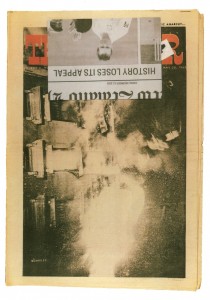 Ms. Menzies’ new exhibition is a “series of new photographic and paper-based works that merge form and content, raising subtle questions about the values inhabiting certain processes and styles, as seen [in] the predominantly activist and underground press material that comprise the collection.” (Professor Barry Rosenberg). Ms. Menzies will also present a 16mm film from 2013, entitled The Press, Kodak Eastman 5222.
Ms. Menzies’ new exhibition is a “series of new photographic and paper-based works that merge form and content, raising subtle questions about the values inhabiting certain processes and styles, as seen [in] the predominantly activist and underground press material that comprise the collection.” (Professor Barry Rosenberg). Ms. Menzies will also present a 16mm film from 2013, entitled The Press, Kodak Eastman 5222.
Ms. Menzies gave a gallery talk on Time to Think Like a Mountain on Wednesday, Oct. 8 to an appreciative audience in the Contemporary Art Galleries, Art Building. The exhibition will run through November 21, 2014, For more information contact Professor Rosenberg at 860.486.1511.
Our new exhibit — Hard Work: Connecticut’s Laborers in the Industrial Age
This exhibit shows scenes of Connecticut’s workers doing Hard Work. Capital H, Capital W. The kind of work where you surely need the brains but if you ain’t got the brawn it’s not gonna happen. And we’ve got plenty of photographs in our business collections showing the men and women in the state in various depictions of work where some of the main job requirements are muscle and sweat. I’m sure tears were there somewhere but the photographs don’t really show that.
In the late 19th and early 20th century — a time period in America known for big industry — Connecticut was one of the major players, producing brass, iron, steel, tools, textiles and more for the state, the country, and the world. These products didn’t just happen. It took a workforce of thousands, many of them new immigrants who flocked to Connecticut for these types of jobs, to produce, to make, to build, and to work.
Janet Lawler’s Blog Post 2: Looking at Layers
Looking at Layers
A picture book starts with a great story told in words (and in the sound of words read out loud). Illustrations accompany the author’s story. In the best picture books, the illustrations actually expand the story. The adult reader, as well as the child listening, feast visually on these layers that enrich the text in delightful and often unexpected ways.
As a picture book author, I focus my drafting and revision efforts on the story I want to tell. An illustrator’s considerable contribution to the final product most often comes long after I am done with my personal revision process (and any revisions guided by an acquiring editor). The publisher’s editor and art director usually select, guide, and supervise the artist. So the illustrator’s role seems a bit remote to me as I ply my craft. But remembering that layers can and should be added via art will help me create opportunities for an illustrator to deepen and expand my stories.
As I study the NCLC author/illustrator archives, I am examining the layering of art in picture books created by author/illustrators, whose creative talents allow them to tackle the words and art together. Author/illustrators don’t forget to leave room for layers—they create them as the picture book progresses in a unified way. They revise both words and illustrations to create balance and get it “just right.”
What does one find in the layers added to a picture book by illustration? Here are some thoughts, based on examples from author/illustrator archival material.
Emotion
Anita Riggio writes and illustrates from the heart. Emotion is the starting point for her wonderful stories. In Smack Dab in the Middle, Rosie Roselli is “smack dab in the middle” of her large, busy Italian family. Her many joyful accomplishments at school are ignored when she tries to share them at home, and she starts to wonder if maybe she isn’t the center of her loving family universe after all.
As I reviewed Anita’s process for Smack Dab in the Middle, I studied the text and illustrations on each spread, comparing what each separately communicates to readers. A particularly touching spread contains these words on page 20:
Rosie Roselli
really needed a hug.
She needed a hug
right this minute,
but her mother’s arms
were full of Rosie’s sister.
Rosie Roselli couldn’t wait.
She stepped up close.
She breathed in.
Talcum powder
and lavender water.
It smelled like a hug.
But it didn’t feel
like one.
Then and there,
Rosie Roselli decided
just want she
must do.
Anita’s evocative words tell us of Rosie’s need; they give the reader an expanded sense of story by dwelling on the scents (which can’t be illustrated) that she associates with her mother.
The related illustration (see below) shows Rosie’s mom’s back turned; she is attending to Rosie’s sister. Rosie’s head is bowed, her eyes are closed. The text doesn’t say, “Rosie felt disappointed, ignored, and rejected.” Those emotions are flowing from the illustration, creating a strong emotional layer to add to and support the text. (Even Anita’s placement of text and art emphasize Rosie’s loneliness here; the text snakes down the left page of this spread; there is empty space continuing onto the right page, where mom is facing away, almost out of the picture at the far right margin.)
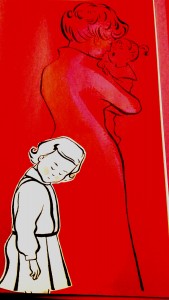 Riggio, Anita. Smack Dab In the Middle! (New York: G.P. Putnam’s Sons, 2002), 21. Photo taken from CLDC776, Archives and Special Collections at the Thomas J. Dodd Research Center, University of Connecticut Libraries.
Riggio, Anita. Smack Dab In the Middle! (New York: G.P. Putnam’s Sons, 2002), 21. Photo taken from CLDC776, Archives and Special Collections at the Thomas J. Dodd Research Center, University of Connecticut Libraries.
Plot expansion
Sometimes, illustrations take readers to places not even mentioned in the text. In Mabel the Tooth Fairy and How She Got Her Job, Katie Davis had some ideas about what might happen to a tooth fairy who works in the dark. The starting point for such an opportunity (to take the reader places) is text that is spare and full of possibilities. Here are three variations of a line of text Katie entertained (the third is final text):
After a few false starts, Mabel was considered an expert in the field.
After a few false starts, Mabel got to really like her work.
Working in the dark presented its own challenges.
All text versions support the three scenes shown below, although the final version perhaps is the funniest, with its spare understatement. The illustrations show the tooth fairy being accosted by the household mutt, slipping and falling on spilled “marbles,” and making noise by stepping on a toy horn.
The pictures transport the reader; the text does not say, “The dog of the house attacked me. I stumbled over a jar of spilled eyeballs…” Another whole layer of action/plot (with humor—the marble jar reads, “Slimy Eyeball Game”) has been added to the story through these illustrations.
Davis, Katie. Mabel the Tooth Fairy and How She Got Her Job (Orlando: Harcourt, Inc., 2003), 16. Photo taken from CLCD1438, Archives and Special Collections at the Thomas J. Dodd Research Center, University of Connecticut Libraries.
Humor
Author/illustrator Tomie dePaola also shares humor via his illustrations. His creative process for Strega Nona Meets Her Match began with a handwritten story accompanied by parenthetical notes to his editor. In this picture book, Big Anthony (Strega Nona’s loyal lunk of an assistant) “defects” to work for the competition, Strega Amelia. When Strega Amelia is away and Big Anthony is left in charge, he messes up the magic big time. Tomie’s earliest draft includes pertinent text (italicized) as well as his illustration ideas set forth in parentheses:
Big Anthony was in charge! (Series of pictures showing Big Anthony reading instructions and making big mistakes on the Husband and Wife wheel – mismatched couples – confusing wart cream and hair restorer – hair falls out, warts increase.)
Things weren’t going too well. (Source:Tomie dePaola Papers Box 41:125K).
Tomie then created illustrations (see below example of mixing up wart cream and hair restorer) to develop the humor of Big Anthony’s bumbling efforts.
Illustration for Strega Nona Meets Her Match, folder 125Y, Box 41 of Tomie dePaola papers. All rights reserved. No reproduction of any kind allowed.
What is interesting, however, is that Tomie’s editor suggested adding text to provide more at this point in the story, explaining that “for read aloud purposes it was important to have a few words.” (Source: Letter from Margaret Frith, Tomie dePaola Papers: Box 41:125L). Ultimately, the spare text was revised as suggested, and lengthened to:
Big Anthony smiled. He was in charge.
The first day he ran the husband and wife machine backwards.
The second day he confused the wart cream with the hair restorer.
Things weren’t going well.
As an author, I suspect that this lengthier text is where I would start my writing process for the same story action. How else would a reader know of the funny mishaps I envision? One possibility would be to include brief illustration suggestions to go with spare text. However, unlike an author/illustrator, who can write such notes to him or herself or to the editor (as Tomie did), an author must tread carefully when making suggestions for art so as not to be directing or limiting the illustrator’s creativity.
The right balance of text and art is achieved on pages 21–23 of the published book (see below). The complexity of Tomie’s illustration panels benefit from the added text that helps communicate his intent and humor regarding Big Anthony’s bumbling. The added text also nicely paces the story, allowing the reader to dwell on these silly mishaps.
[text: Big Anthony smiled. He was in charge.]
[text: The first day he ran the husband-and-wife machine backward.]
[text: The second day he confused the wart cream with the hair restorer.]
dePaola, Tomie. Strega Nona Meets Her Match (New York: G.P. Putnam’s Sons, 1993), 21–23. Photo taken from CLDC776, Archives and Special Collections at the Thomas J. Dodd Research Center, University of Connecticut Libraries.
Authors as well as author/illustrators must be mindful that there is a balance to be found between the read-aloud component and the illustrations in a picture book. However, an author who writes minimal text (even though he or she has a vision for what an illustrator might add) may run the risk of creating a manuscript that seems too slight or unclear to an editor, or perhaps, to young readers who may need some words to decode illustrations.
Conclusion
As I write and revise stories, I’ll keep thinking about layers. I’ll remember that my words need not dwell on emotions that an artist can convey with illustrations. I will deepen stories by words that can’t be shown in the art. I’ll choose words that may give an illustrator opportunities to take my protagonist to places (literally) other than those I may have had in mind. And if I am writing “funny,” I’ll strive for spare text that will encourage a clever artist to add visual jokes and hyperbole. I shall have trust to let an illustrator help tell my story—so that “our” story will marry text and art in a truly memorable picture book.
About Janet Lawler:
A recipient of a 2014 Billie M. Levy Research grant, Janet Lawler of Farmington, CT, is studying the relationship between art and text in picture books at the Northeast Children’s Literature Collection. Through studying the work and process of author-illustrators, she hopes to better understand how a story’s text interfaces with the art. She is searching for a deeper comprehension of why the best picture books are those where the final product is “greater” than the sum of the parts (text + illustrations). She looks forward to applying knowledge gleaned from her research to her own work process as a children’s author.
Ms. Lawler’s picture books have been published by major and specialty publishers. Two have been Children’s Book of the Month Club main selections, and two have been licensed into the Scholastic Book Clubs. If Kisses Were Colors has been translated into Spanish, Japanese, Hebrew, and Korean. Her recent credits include Ocean Counting (National Geographic, 2013 (named a 2014 Outstanding Science Trade Book by the National Science Teachers Association)) and Love Is Real (HarperCollins, 2014). National Geographic will publish Rain Forest Colors in November of 2014.



